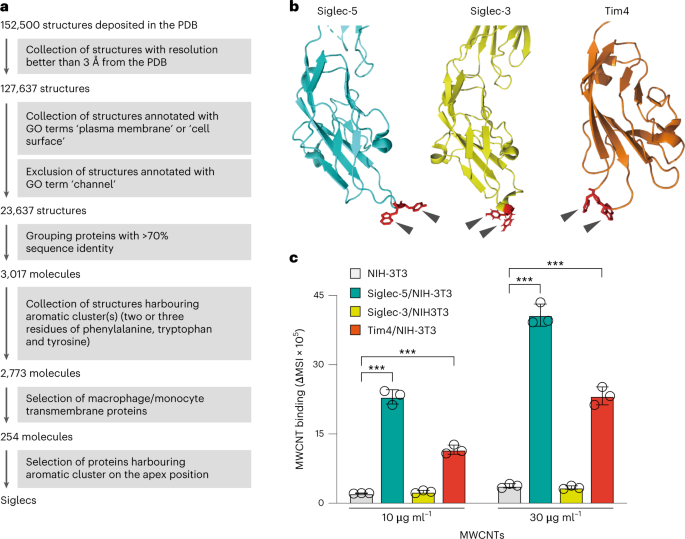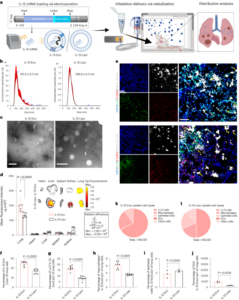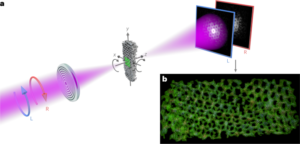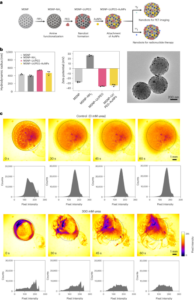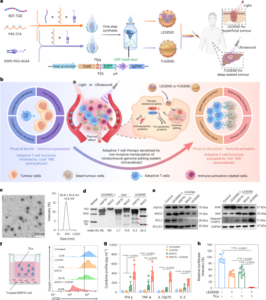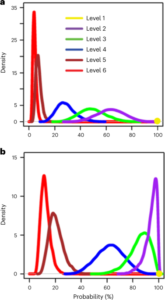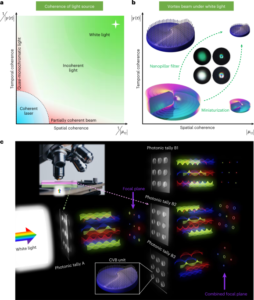
De Volder, M. F., Tawfick, S. H., Baughman, R. H. & Hart, A. J. Carbon nanotubes: present and future commercial applications. Science 339, 535–539 (2013).
Huang, H., Feng, W., Chen, Y. & Shi, J. L. Inorganic nanoparticles in clinical trials and translations. Nano Today 35, 100972 (2020).
Hansen, S. F. & Lennquist, A. SIN list criticism based on misunderstandings. Nat. Nanotechnol. 15, 418 (2020).
Nel, A. E. et al. Understanding biophysicochemical interactions at the nano–bio interface. Nat. Mater. 8, 543–557 (2009).
Rennick, J. J., Johnston, A. P. R. & Parton, R. G. Key principles and methods for studying the endocytosis of biological and nanoparticle therapeutics. Nat. Nanotechnol. 16, 266–276 (2021).
Yang, W., Wang, L., Mettenbrink, E. M., DeAngelis, P. L. & Wilhelm, S. Nanoparticle toxicology. Annu. Rev. Pharmacol. Toxicol. 61, 269–289 (2021).
Poland, C. A. et al. Carbon nanotubes introduced into the abdominal cavity of mice show asbestos-like pathogenicity in a pilot study. Nat. Nanotechnol. 3, 423–428 (2008).
Nagai, H. et al. Diameter and rigidity of multiwalled carbon nanotubes are critical factors in mesothelial injury and carcinogenesis. Proc. Natl Acad. Sci. USA 108, E1330–E1338 (2011).
Donaldson, K., Murphy, F. A., Duffin, R. & Poland, C. A. Asbestos, carbon nanotubes and the pleural mesothelium: a review of the hypothesis regarding the role of long fibre retention in the parietal pleura, inflammation and mesothelioma. Part. Fibre Toxicol. 7, 5 (2010).
Dostert, C. et al. Innate immune activation through Nalp3 inflammasome sensing of asbestos and silica. Science 320, 674–677 (2008).
Franklin, B. S., Mangan, M. S. & Latz, E. Crystal formation in inflammation. Annu. Rev. Immunol. 34, 173–202 (2016).
Palomaki, J. et al. Long, needle-like carbon nanotubes and asbestos activate the NLRP3 inflammasome through a similar mechanism. ACS Nano 5, 6861–6870 (2011).
Miyanishi, M. et al. Identification of Tim4 as a phosphatidylserine receptor. Nature 450, 435–439 (2007).
Omori, S. et al. Tim4 recognizes carbon nanotubes and mediates phagocytosis leading to granuloma formation. Cell Rep. 34, 108734 (2021).
Kobayashi, N. et al. TIM-1 and TIM-4 glycoproteins bind phosphatidylserine and mediate uptake of apoptotic cells. Immunity 27, 927–940 (2007).
Berman, H., Henrick, K., Nakamura, H. & Markley, J. L. The worldwide Protein Data Bank (wwPDB): ensuring a single, uniform archive of PDB data. Nucleic Acids Res. 35, D301–D303 (2007).
Duan, S. & Paulson, J. C. Siglecs as immune cell checkpoints in disease. Annu. Rev. Immunol. 38, 365–395 (2020).
Crocker, P. R., Paulson, J. C. & Varki, A. Siglecs and their roles in the immune system. Nat. Rev. Immunol. 7, 255–266 (2007).
Hayami, T., Higo, J., Nakamura, H. & Kasahara, K. Multidimensional virtual-system coupled canonical molecular dynamics to compute free-energy landscapes of peptide multimer assembly. J. Comput. Chem. 40, 2453–2463 (2019).
Jumper, J. et al. Highly accurate protein structure prediction with AlphaFold. Nature 596, 583–589 (2021).
Angata, T., Hingorani, R., Varki, N. M. & Varki, A. Cloning and characterization of a novel mouse Siglec, mSiglec-F: differential evolution of the mouse and human (CD33) Siglec-3-related gene clusters. J. Biol. Chem. 276, 45128–45136 (2001).
Angata, T., Hayakawa, T., Yamanaka, M., Varki, A. & Nakamura, M. Discovery of Siglec-14, a novel sialic acid receptor undergoing concerted evolution with Siglec-5 in primates. FASEB J. 20, 1964–1973 (2006).
Wilson, A. A. et al. Amelioration of emphysema in mice through lentiviral transduction of long-lived pulmonary alveolar macrophages. J. Clin. Invest. 120, 379–389 (2010).
Yamanaka, M., Kato, Y., Angata, T. & Narimatsu, H. Deletion polymorphism of Siglec14 and its functional implications. Glycobiology 19, 841–846 (2009).
Toyokuni, S. Genotoxicity and carcinogenicity risk of carbon nanotubes. Adv. Drug Deliv. Rev. 65, 2098–2110 (2013).
D’Astolfo, D. S. et al. Efficient intracellular delivery of native proteins. Cell 161, 674–690 (2015).
Gonzalez-Durruthy, M., Concu, R., Ruso, J. M. & Cordeiro, M. New mechanistic insights on carbon nanotubes’ nanotoxicity using isolated submitochondrial particles, molecular docking, and nano-QSTR approaches. Biol. (Basel) 10, 171 (2021).
Ge, C. et al. Binding of blood proteins to carbon nanotubes reduces cytotoxicity. Proc. Natl Acad. Sci. USA 108, 16968–16973 (2011).
Zhang, J. et al. Molecular recognition using corona phase complexes made of synthetic polymers adsorbed on carbon nanotubes. Nat. Nanotechnol. 8, 959–968 (2013).
Lanzarotti, E., Defelipe, L. A., Marti, M. A. & Turjanski, A. G. Aromatic clusters in protein–protein and protein–drug complexes. J. Cheminform. 12, 30 (2020).
Westbrook, J., Ito, N., Nakamura, H., Henrick, K. & Berman, H. M. PDBML: the representation of archival macromolecular structure data in XML. Bioinformatics 21, 988–992 (2005).
Kinjo, A. R. et al. Protein Data Bank Japan (PDBj): updated user interfaces, resource description framework, analysis tools for large structures. Nucleic Acids Res. 45, D282–D288 (2017).
Fu, Q. et al. Stimuli-responsive plasmonic assemblies and their biomedical applications. Nano Today 36, 101014 (2021).
Jorgensen, W. L., Maxwell, D. S. & TiradoRives, J. Development and testing of the OPLS all-atom force field on conformational energetics and properties of organic liquids. J. Am. Chem. Soc. 118, 11225–11236 (1996).
Jorgensen, W. L., Chandrasekhar, J., Madura, J. D., Impey, R. W. & Klein, M. L. Comparison of simple potential functions for simulating liquid water. J. Chem. Phys. 79, 926–935 (1983).
Darden, T., York, D. & Pedersen, L. Particle mesh Ewald—an N.log(N) method for Ewald sums in large systems. J. Chem. Phys. 98, 10089–10092 (1993).
Essmann, U. et al. A smooth particle mesh Ewald method. J. Chem. Phys. 103, 8577–8593 (1995).
Abraham, M. J. et al. Gromacs: high performance molecular simulations through multi-level parallelism from laptops to supercomputers. SoftwareX 1-2, 19–25 (2015).
Berendsen, H. J. C., Postma, J. P. M., Vangunsteren, W. F., Dinola, A. & Haak, J. R. Molecular-dynamics with coupling to an external bath. J. Chem. Phys. 81, 3684–3690 (1984).
Nose, S. A molecular-dynamics method for simulations in the canonical ensemble. Mol. Phys. 52, 255–268 (1984).
Hess, B., Bekker, H., Berendsen, H. J. C. & Fraaije, J. G. E. M. LINCS: a linear constraint solver for molecular simulations. J. Comput. Chem. 18, 1463–1472 (1997).
Daszykowski, M & Walczak, B. In Comprehensive Chemometrics (eds Brown, S. D., Tauler, R. & Walczak, B.), 635–654 (Elsevier, 2009).
Huerta-Cepas, J., Serra, F. & Bork, P. ETE 3: reconstruction, analysis, and visualization of phylogenomic data. Mol. Biol. Evol. 33, 1635–1638 (2016).
Price, M. N., Dehal, P. S. & Arkin, A. P. FastTree 2—approximately maximum-likelihood trees for large alignments. PLoS One 5, e9490 (2010).
Varadi, M. et al. AlphaFold Protein Structure Database: massively expanding the structural coverage of protein-sequence space with high-accuracy models. Nucleic Acids Res. 50, D439–D444 (2022).
Tsugita, M., Morimoto, N., Tashiro, M., Kinoshita, K. & Nakayama, M. SR-B1 Is a silica receptor that mediates canonical inflammasome activation. Cell Rep. 18, 1298–1311 (2017).
Kitamura, T. et al. Retrovirus-mediated gene transfer and expression cloning: powerful tools in functional genomics. Exp. Hematol. 31, 1007–1014 (2003).
Naito, Y., Hino, K., Bono, H. & Ui-Tei, K. CRISPRdirect: software for designing CRISPR/Cas guide RNA with reduced off-target sites. Bioinformatics 31, 1120–1123 (2015).
Sanjana, N. E., Shalem, O. & Zhang, F. Improved vectors and genome-wide libraries for CRISPR screening. Nat. Methods 11, 783–784 (2014).
Lam, C. W., James, J. T., McCluskey, R., Arepalli, S. & Hunter, R. L. A review of carbon nanotube toxicity and assessment of potential occupational and environmental health risks. Crit. Rev. Toxicol. 36, 189–217 (2006).
Flynn, R. et al. Targeting Syk-activated B cells in murine and human chronic graft-versus-host disease. Blood 125, 4085–4094 (2015).
Agarwal, K. et al. Inhibition of mucin-type O-glycosylation through metabolic processing and incorporation of N-thioglycolyl-d-galactosamine peracetate (Ac(5)GalNTGc). J. Am. Chem. Soc. 135, 14189–14197 (2013).
Ito, F. et al. Asbestos conceives Fe(II)-dependent mutagenic stromal milieu through ceaseless macrophage ferroptosis and β-catenin induction in mesothelium. Redox Biol. 36, 101616 (2020).
Maejima, I. et al. Autophagy sequesters damaged lysosomes to control lysosomal biogenesis and kidney injury. EMBO J. 32, 2336–2347 (2013).
- SEO Powered Content & PR Distribution. Get Amplified Today.
- Platoblockchain. Web3 Metaverse Intelligence. Knowledge Amplified. Access Here.
- Source: https://www.nature.com/articles/s41565-023-01363-w
- :is
- ][p
- 1
- 10
- 11
- 1996
- 2001
- 2011
- 2014
- 2016
- 2017
- 2019
- 2020
- 2021
- 2022
- 28
- 39
- 7
- 8
- 9
- a
- accurate
- Activation
- AL
- analysis
- and
- applications
- approaches
- Archive
- ARE
- article
- AS
- Assembly
- assessment
- At
- Bank
- based
- Basel
- bind
- binding
- biomedical
- blood
- by
- carbon
- carbon nanotubes
- Cells
- chen
- click
- Clinical
- clinical trials
- CO
- commercial
- comparison
- comprehensive
- Compute
- concerted
- control
- Corona
- coupled
- coverage
- CRISPR
- critical
- criticism
- Crystal
- data
- Database
- delivery
- description
- designing
- Development
- discovery
- Disease
- drug
- dynamics
- e
- efficient
- ensuring
- environmental
- Ether (ETH)
- evolution
- expanding
- external
- factors
- field
- For
- Force
- formation
- Framework
- from
- functional
- functions
- future
- genomics
- guide
- Health
- High
- highly
- http
- HTTPS
- human
- i
- Identification
- Immune system
- implications
- improved
- in
- inflammation
- innate
- insights
- interactions
- Interface
- interfaces
- introduced
- Invest
- isolated
- ITS
- Japan
- Key
- kidney
- laptops
- large
- leading
- libraries
- LINK
- Liquid
- List
- Long
- made
- massively
- Maxwell
- mechanism
- method
- methods
- mice
- models
- molecular
- native
- Nature
- New
- novel
- occupational
- of
- on
- organic
- particle
- performance
- phase
- pilot
- plato
- Plato Data Intelligence
- PlatoData
- Poland
- Polymers
- potential
- powerful
- prediction
- present
- principles
- processing
- properties
- Protein
- Proteins
- recognition
- recognizes
- Reduced
- reduces
- regarding
- representation
- resource
- retention
- review
- Risk
- risks
- RNA
- Role
- roles
- s
- SCI
- screening
- show
- similar
- Simple
- single
- Sites
- Software
- Space
- structural
- structure
- Study
- Studying
- supercomputers
- synthetic
- system
- Systems
- targeting
- Testing
- that
- The
- their
- therapeutics
- Through
- to
- tools
- transfer
- Translations
- Trees
- trials
- understanding
- updated
- User
- visualization
- W
- Water
- with
- worldwide
- XML
- zephyrnet

